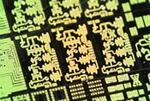New semiconductor technology flies into space
Direktzugriff
Artikelaktionen
[Translate to English:] Prozessierte X-Band-Verstärkerschaltungen auf Basis des Halbleiters Galliumnitrid. Die Schaltung für Proba-V hat eine Größe von nur 2 x 3,5 mm2.
The satellite which the European Space Agency ESA will launch into space in the coming weeks for earth observation weighs about 140 kg and is only roughly the size of a washing machine. The mini-satellite Proba-V is covered in solar cells and will be observing the vegetation on earth. Every other day, the environmental satellite will send pictures from a distance of about 820 km. Rain forest destruction, pollution of the seas and soil erosion will be made visible by pictures taken in various spectral ranges.
For the first time, a European device based on the semiconductor gallium nitride (GaN) will be sent into space. »Gallium nitride has the potential to revolutionize communication in space. We expect signal strength and data transmission to improve five- or tenfold«, says Andrew Barnes, who is responsible for the project at ESA. »We are eagerly awaiting the results of the first practical test in space«. The Fraunhofer Institute for Applied Solid State Physics IAF in Freiburg has developed an amplifier circuit for the frequency range of 8 – 8.5 GHz (X-band) for the communication system of Proba-V. Tesat-Spacecom in Backnang, in cooperation with SCHOTT Electronic Packaging, then packaged the gallium nitride amplifier together with further components into a hermetically sealed housing suitable for space travel.
Gallium nitride in stress tests: robust and reliable
Gallium nitride devices can be operated under much higher voltages and temperatures than traditional silicon or gallium arsenide components. The circuits are more compact, smaller and lighter than other solutions. They might even replace electron tubes currently used for amplification. This would significantly reduce weight and transport costs, which can amount to 30,000 euros per kilogram of payload. Due to the long lifetime and radiation hardness of the semiconductor material, such electronic devices are ideally suited for the extreme conditions posed by aerospace.
Before being admitted for space travel, however, the gallium nitride device had to prove its resilience. The device was exposed to cold and heat, strong vibration and motion as well as radiation. »Accelerated lifetime tests, conducted together with Tesat-Spacecom, have shown that our gallium nitride amplifier will live for at least 20 years«, says Dr. Patrick Waltereit, project leader at Fraunhofer IAF. »The approval of our device for the flight into space is an important milestone for the further development of gallium nitride technology, also for other areas of application«.
Power semiconductor pushes the limits of silicon technology
Due to its exceptional physical properties, gallium nitride is ideally suited for applications in power electronics. Compared to conventional semiconductors such as silicon and gallium arsenide, gallium nitride possesses a larger bandgap (3.4 eV) and higher breakdown field strength (3.3 MV/cm). Higher dielectric strength and current density result in a fivefold increase in power density. Moreover, the usable frequency range is larger in gallium nitride, which allows several functions to be integrated on one chip. The thermal robustness of the semiconductor results in a considerable decrease of cooling effort, which is both energy- and cost-efficient. This makes compact and energy-efficient gallium nitride devices interesting not only for applications in aeronautics, but also for voltage converters for the batteries of electric cars, solar panels or household appliances. As such, these devices offer high potential especially for applications which demand high performance and long lifetime even in harsh environmental conditions. This is where silicon technology meets its limits.
About the project
The European Space Agency ESA founded the initiative Great² (»GaN Reliability Enhancement and Technology Transfer Initiative«) in order to exploit the potential of gallium nitride technology for aeronautics. Together with industrial partners, renowned research institutes in the field of III-V semiconductors, such as Fraunhofer IAF, develop high quality gallium-nitride-based devices under the project leadership of Tesat-Spacecom, thus strengthening the competitiveness of the European aerospace industry.
Fußzeile
Benutzerspezifische Werkzeuge

